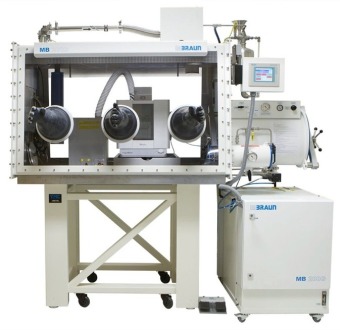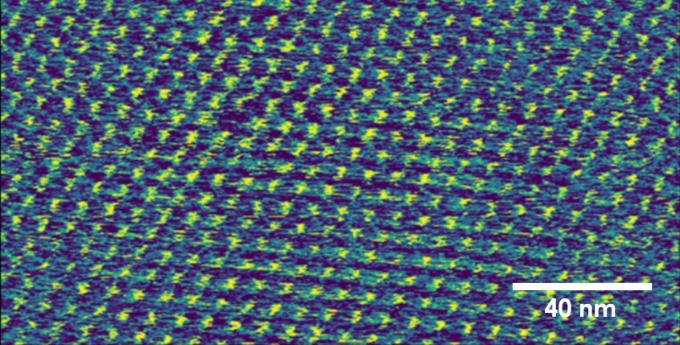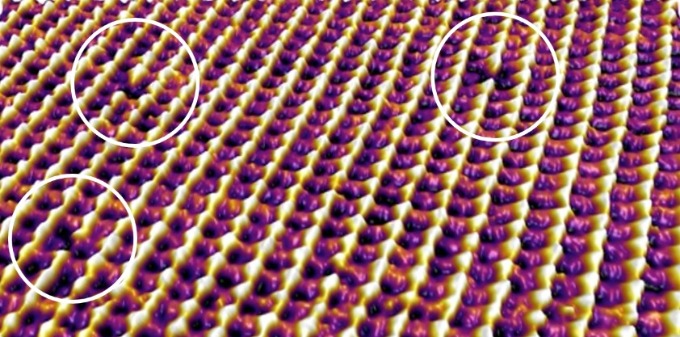AFM Systems
AFM Accessories
Learning
Contact Us
 Part of the Oxford Instruments Group
Part of the Oxford Instruments Group
Air-sensitive 2D materials can be challenging to image with atomic force microscopy (AFM) in a glovebox, with noise from the associated pumps and fans not being conducive for the typical AFM. The Cypher AFM however, with its high vibration immunity, can routinely achieve atomic resolution in a glovebox, and does so without even any vibration isolation. Figure 1 shows an example of the Cypher glovebox configuration.
 Figure 1: The Cypher AFM in a MB200 glovebox routinely achieves atomic resolution even without vibration isolation.
Figure 1: The Cypher AFM in a MB200 glovebox routinely achieves atomic resolution even without vibration isolation.
AFM is crucial for directly providing the moiré lattice periodicity of twisted 2D materials with a variety of techniques,1 allowing researchers to precisely measure twist angles and surface features at the nanoscale. This measurement is crucial for addressing twist angle disorder in moiré physics, where even slight deviations in the twist angle can markedly influence the material's electronic properties. Imaging must be conducted within an inert glovebox environment for 2D samples that are susceptible to oxidation and moisture, such as many 2D transition metal dichalcogenides (TMDs).2
AFM of air-sensitive twisted 2D TMDs
TMDs have rapidly emerged as a fascinating class of quantum materials due to the formation of moiré lattices when two layers are rotated relative to each other. Molybdenum ditelluride (MoTe₂) has garnered significant attention following the first ever observation of the fractional quantum anomalous Hall effect,3 underscoring its potential in unveiling novel quantum phases.

Figure 2: The moiré of air-sensitive twisted molybdenum ditelluride (MoTe2) imaged with the Cypher AFM in a glovebox.
Figure 2 shows the moiré of twisted MoTe2 taken with a Cypher S AFM housed inside an argon-filled glovebox, where oxygen and moisture levels were maintained below 0.5 ppm. Piezoresponse force microscopy (PFM) mode revealed a moiré periodicity of 5.5 nm, corresponding to a twist angle of approximately 3.7° - the very angle at which the fractional quantum anomalous Hall effect has been reported. The identified area with the desired twist angle and homogeneity offers an ideal region for device fabrication. These observations not only underscore the importance of characterizing twist angle for exploring new quantum states in twisted MoTe₂ but also highlight the precision and vibration immunity of the Cypher AFM despite the relatively noisy glovebox environment.
Cypher vibration immunity
The Cypher AFM’s ability to routinely achieve high resolution, even in traditionally unsuitable environments for AFM such as a glovebox, is attributed to its design. A unique feature of the Cypher AFM’s design, distinct from most other AFMs, is that the cantilever is completely mechanically decoupled from the rest of the AFM’s detection system. This enables the mechanical path between the tip and sample to be very short and rigid, which is, in part, what affords the Cypher AFM its exceptional vibrational immunity. As a demonstration of ultimate resolution, Figure 3 shows a 3D rendered image of single atomic point defects in calcite taken with the Cypher AFM in an active glovebox.

Figure 3: Single point atomic defects in calcite (circled in white) taken with a Cypher in an active glovebox with pumps on. This resolution results from both the AFM’s low noise floor and high vibration immunity.
Conclusion
The unique design of the Cypher AFM confers a high level of vibration immunity that enables atomic resolution to be routinely achieved, even in an active glovebox with running pumps. As a result, the moiré periodicity of air-sensitive 2D materials, such as twisted TMDs, can be easily characterized with the Cypher AFM.
References
Date: April 2025
Author: Asylum Research
Category: Application Note
